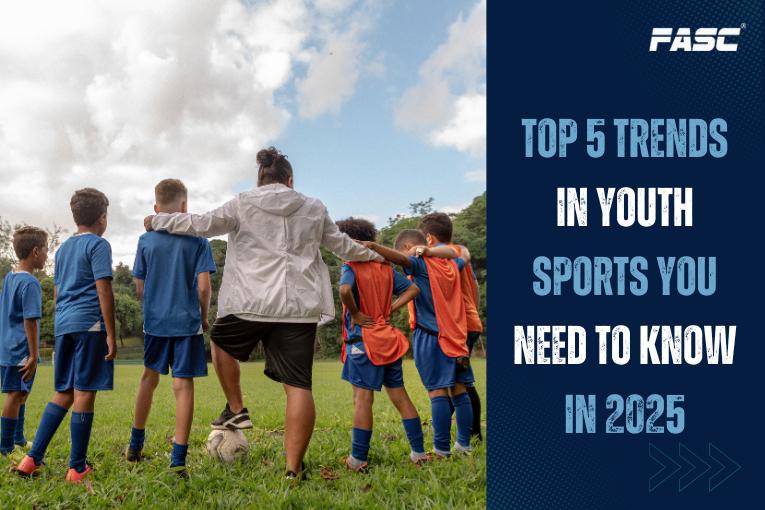- Sports
Top 5 Trends in Youth Sports You Need to Know in 2025

- Jun 03, 2025
Key Takeaways:
- Tech-Driven Training is revolutionizing how kids perform.
- Mental Health is now a core part of youth sports programs.
- Multi-Sport Participation is preferred over early specialization.
- Esports Integration is changing how kids learn and engage..
- Inclusivity and Access are top priorities.
Youth sports have evolved rapidly. In 2025, it's no longer just about competition—it's about developing smarter, healthier, and more well-rounded athletes. Thanks to advances in technology and a growing emphasis on emotional well-being, today’s young athletes are training differently, competing more inclusively, and learning life skills along the way.
Here are the top 5 trends shaping youth sports in 2025:
1. Tech-Driven Training Is the New Normal
Wearables, AI tools, and performance-tracking apps are now standard. Kids don’t just play—they analyze and improve using real-time data.
Key innovations:
-
Wearables: Devices like WHOOP and Apple Watch monitor heart rate, recovery, and sleep. Coaches use this to tailor training and reduce injuries, while athletes learn to understand their bodies better.
Source -
AI Coaching Tools: Apps like HomeCourt and OnForm use computer vision to give real-time feedback on movement, helping kids refine technique more efficiently than ever.
-
Virtual Reality (VR): VR-based drills are helping kids sharpen decision-making and cognitive skills without physical strain, used especially in elite training programs.
This tech-first approach helps athletes play smarter—not just harder.
2. Mental Health and Emotional Wellness Take Center Stage
Burnout and performance anxiety have long impacted youth sports. In 2025, there’s a clear shift toward prioritizing mental wellness.
What’s changing:
-
Mindfulness Training: Breathing techniques, focus exercises, and emotional regulation are now built into training programs to build resilience.
Source -
Mental Health Apps: Tools designed for young athletes offer guided sessions to handle anxiety, boost confidence, and support post-competition recovery.
-
Emotional stress and fatigue: There’s a growing emphasis on creating safe, supportive team environments where kids feel heard and encouraged—not just pushed to perform.Coaches are being trained to spot warning signs like withdrawal.
Mental check-ins are becoming as routine as physical evaluations, helping build confident, emotionally healthy athletes.
3. Multi-Sport Participation Is Making a Comeback
For years, early specialization was common—but it often led to burnout and injury. In 2025, doctors, coaches, and athletes are encouraging multi-sport play.
Why it’s important:
-
Enhanced Athleticism: Different sports develop different skills—basketball improves agility, swimming builds endurance, and martial arts enhance discipline and balance.
Source -
Mental Engagement: Rotating sports keeps things fun and prevents mental fatigue or boredom.
-
Better Long-Term Performance: Athletes like Roger Federer and Patrick Mahomes played multiple sports growing up, building transferable skills that contributed to elite performance.
Even college recruiters now favor multi-sport athletes for their adaptability and broad skill sets.
4. Esports and Traditional Sports Are Converging
Once seen as opposites, esports and physical sports are now working together to improve youth development.
Emerging practices:
-
Simulation Games: Titles like FIFA and NBA2K are being used to teach real-world strategy, rules, and game flow in a fun, interactive format.
-
Cognitive Training: Virtual coaching platforms simulate in-game decisions, helping athletes build tactical thinking and pressure handling.
Source -
Skill Crossover: Esports help develop reflexes, hand-eye coordination, and teamwork—skills that translate into physical sports.
Instead of competing with physical activity, esports are now being used to enhance it.
5. Inclusivity and Access Are Being Prioritized
One of the most important changes in 2025 is the effort to ensure every child can participate in sports—regardless of background, ability, or gender.
Key initiatives:
-
Scholarships & Grants: Public-private partnerships and nonprofits are providing financial support to cover gear, travel, and club fees for low-income families.
-
Adaptive Sports: Programs are expanding to include kids with physical and intellectual disabilities—offering sports like wheelchair basketball and unified soccer.
Source -
Gender-Inclusive Play: Non-gendered leagues in early age groups encourage competition based on skill and interest, not traditional gender roles.
Source
These shifts are helping level the playing field and making youth sports more welcoming for all.
Conclusion
Youth sports in 2025 are about more than winning—they’re about growing up healthy, confident, and capable. From wearable tech and AI coaching to emotional wellness and inclusive access, the game is evolving fast.
Whether you're a coach, parent, or athlete, staying aware of these changes helps support young players in every way—on and off the field.
FAQs
1. Why is multi-sport participation better than early specialization?
It reduces overuse injuries, builds diverse skills, and keeps kids mentally engaged.
2. How is tech changing youth training?
Tools like wearables, VR, and AI apps personalize training and improve performance with data.
3. Are esports replacing physical sports?
No—they complement each other. Esports help develop decision-making, coordination, and game IQ.
4. How can parents support mental health in sports?
Encourage open communication, realistic goals, and use mental fitness apps or mindfulness exercises.
5. What resources help make sports more accessible?
Scholarships, grants, and inclusive programs are expanding access across all communities.
Recent Blog
- Oct 07, 2025
- Oct 03, 2025
- Sep 30, 2025
- Sep 26, 2025





